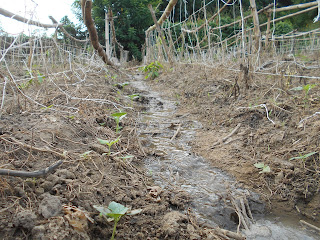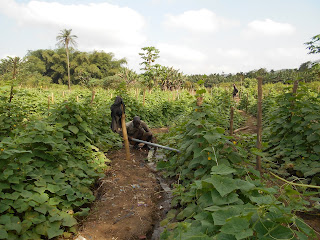On the surface, dry or off season farming has an impressive return on investment due to supply dip and increase in demand of so...
On the surface, dry or off season farming has an impressive return on investment due to supply dip and increase in demand of so many crops however it also comes with demand for high water requirement which is not naturally present around this time. For this foregoing reason, anyone who is interested in dry season farming must find a way of facilitating water supply for irrigation. In this light, there are many options on the table but what determines the option to go for depends on a number of factors: Available resources, crop type, land size, available water source, field design/land scape etc. Among all the options, furrow flooding has the lowest cost of procurement. It thus stands as a good option for any farmer low on cash. Nevertheless, it has it downside as well. In this article, I would talk about everything you need to know about furrow flooding which would inform your decision making during dry season farming.
Cost implication of different irrigation techniques/methods
I would provide simplified budgets for all the common irrigation types available per acre of land. Please note that this represents only an average cost as cost of each item varies from location to another and there are other cost such as miscellaneous cost which is not factored into this calculation.
You may also want to read: Effective way of trellising/staking your climbing veggies
FURROW FLOODING
Material needed:
- Water Pump (2 or 3 inches) and accessories = N55,000
- Flat hose (100m) = N28,000
- 2” PVC pipe (15 pieces) = N9,000
- T-Junction & Elbow (2 pieces each) = N500
- Others = N2000
- Average Total Cost = 94,500
 |
| Furrow Flooding of Cabbage |
SPRAY TUBE
Material needed:
- Water Pump (2 inches/3 inches) plus accessories = N55,000
- Bundle(200m each) of tubes (5 bundles) = N125,000
- 2 inches pipe Or 50 meter flat hoses (26 pieces) = N15,600
- Accessories e.g. valves (32 pieces) = N9,600
- Accessories e.g Bush, PVC gum (32 pieces) = N11,200
- Workmanship = ?
- Average Total Cost (minus workmanship) = N 216,400
DRIP TAPE
Material needed:
- Water Pump + Well or Bole holes = ?
- Bundles of tapes (1000m each, 6 bundles) + Accessories = N480,000
- 2 inches pipes (10 pieces) = N6,000
- Accessories e.g PVC gums = N1000
- Overhead tank (5,000 L)= N60,000
- Workmanship = ?
- Average Total Cost (minus workmanship and bole hole cost) = N547,000
 |
| Planting on the side of the beds |
RAIN GUN
Material needed:
- Water Pump 2 inches/3 inches + accessories =N55,000
- Flat hose (50m) = N12,000
- Gun and stand = N120,000
- Workmanship = ?
- Average Total Cost (minus workmanship) = N187,000
SPRINKLER
Material needed:
- Water Pump 2 inches/3 inches plus accessories = N55,000
- 1 inch hose (50m) (3 bundles) = N180,000
- Sprinkler heads (40 pieces) = N40,000
- Other accessories = N20,000
- Workmanship = ?
Average Total Cost (minus workmanship) = N295,000
What is furrow flooding and does it works?
 |
| Furrow Flooding of cucumber |
Furrow Flood irrigation involves simply pumping or bringing water to the fields and allowing it to flow over the ground in between rows of beds. The furrow should be shallow enough and the crops are planted sometimes on the sides of the beds or rows not on top in order to facilitate their access to enough water easily.
The essentialities of furrow flooding
Among all the listed irrigation types above, furrow flooding is the most affordable but not applicable in all cases. What makes furrow flooding adoptable depends on the following conditions:
- The field design: Furrow flooding can only work effectively in non-sloppy or leveled field, this ensures that the water reaches all part of the field and has even percolation.
- Perennial water source: Furrow flooding uses a lot of water therefore is not suitable for a water source with limited capacity. Ideally, natural water bodies such as river, lake etc. are the best choice
- Water pumping machine: It would require pumping machine to pump the water each time one needs to use the method. It does not work under gravity unlike drip tape. Fuel consumption may be on the high side depending
- Flat hose: You would require flat hose to channel the water from the water source unto the main field before PVC pipes are connected.
- PVC pipe: This are connected temporary (without PVC gum) together towards the location one needs the flooding. Depending on your skill, you may not need pipe.
- Crop type: There are crops such as rice, cucumber, onion that require a lot of water and therefore would not be economic to use any other irrigation type. If you are into large scale cultivation cereal during dry season, flooding method is surely an approachable option.
You may also want to read: How to store your veggies seeds; what must seed companies would not tell you
The downside of furrow flooding
- It requires a practical on-farm engagement skill to use it
- It does not manage water therefore is not a good option where water source has limited capacity
- It could erode transplanted seedlings or planted seeds where it is not done with care
- It encourages weed growth
- Fuel consumption is relatively high but this may be irrelevant since interval of wetting is days apart since each wetting ensures adequate saturation of the soil
Now that you are ready
If you think you want to do dry season farming and you are low on cash, you can achieve the same result with those with more advanced irrigation materials; all you need to do is to locate a leveled field close to perennial water source with limitless water capacity.
If you have any personalized question is bringing this to reality, you may contact us for advice. Happy dry season farming! Do remember to like us on Facebook and subscribe to our instagram page to access more resources materials and techniques on farming. You may also do email subscription to receive latest and finest of our series of articles on modern farming techniques and much more.

















COMMENTS